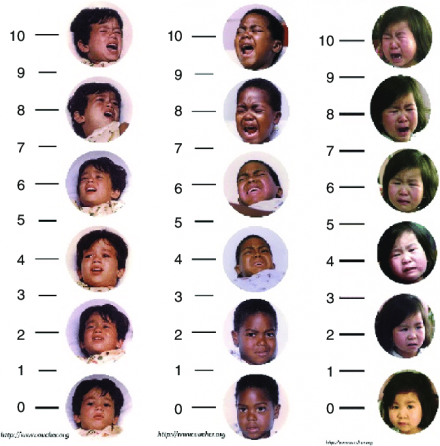Tylee as an Infant
Tylee's mother had to advocate for her young son to receive effective pain treatment at six months old.
Tylee experienced a health care disparity, which often occurs with sickle cell disease related pain.
Pain is a subjective symptom that is not always taken seriously by health care professionals.
Tylee's Diagnosis at Six Months
- Prior positive neonatal screening for Sickle Cell Disease (SCD)
- Painful swelling in hands and feet (dactylitis)
- Swelling in other joints
- Fever
- Enlarged spleen
- Mild jaundice
- Anemia
Pain Assessment Tools
- Pain assessment in infants and young (preverbal) children rely on behavioral measures (i.e., crying, limited movement, restlessness or facial expression)
- Parents can learn to recognize how their infant expresses pain over time
- Health care providers should partner with parents to help them learn and understand how to recognize pain
- Physiologic measures (e.g., rapid breathing, accelerated heart rate) also can be used to recognize pain in an infant or young child
- Behavioral assessment tools are available for infants and young children
Sickle Cell Pain
A complete pain assessment in a child with sickle cell disease includes:
- Evaluating pain intensity
- How much it hurts
- Assessing sensory and affective characteristics
- What the pain feels like
- How the pain makes the child feel
- Identifying pain location(s)
- Where it hurts
- Describing alleviating and aggravating factors
- What makes it worse and what makes it better
Oucher Scale

- The OUCHER is a poster developed for children to help them communicate how much pain or hurt they feel.
- There are two scales on the OUCHER: a number scale for older children and a picture scale for younger children.
- Children, who are able to count to 100 by ones or tens and who understand e.g., that 71 is larger than 43, can use the numerical sclae.
- Children who do not understand numbers should use the picture scale.
- Some children who are able to use the number scale might prefer to use the picture scale.
- Ask the child which scale he or she would prefer.
Faces Scale
- This tool was originally created with children for children to help them communicate about their pain.
- Now the scale is used around the world with people ages 3 and older, facilitating communication and improving assessment so pain management can be addressed.

Reference
Wong-Baker FACES Pain Rating Scale. Available at https://wongabkerfaces.org/; Oucher! Available at http://oucher.org/differences.html
Tylee's Treatment
- Liquid opioid analgesic titrated to pain relief with observation for side effects
- Oral, rectal, or intravenous acetaminophen
- NSAID; oral ibuprofen, intravenous ketorolac
- Immunizations to avoid infection
- Heat
- Massage
Opioid Use in Children with Sickle Cell Disease (SCD)
- Opioids effectively reduce moderate-severe pain
- Reduce the amount of opioids if possible to minimal effective dose
- Monitor patient for adverse effects
- Supervised administration should always occur with opioids
Acute
- Small but trivial risk of opioid liking, which can lead to addiction
- Acute use promotes faster recovery
- Reduces pain and suffering
- Can be done safely
- Need to treat acute pain well
Chronic
- Less clear if they provide benefit long term
- Patient selection is key
- Constant monitoring is important
- Willingness to stop use if risk exceeds benefit
Reference
Kanter J Kruse-Jarres R: Management of sickle cell disease from childhood through adulthood. Blood Rev 27 6:279-287, 2013
Tylee's Mom Speaks with Nurse
Tylee's Nurse Speaks With the Doctor
Safe Use of Opioids at Home
Educating Parents
Parents MUST be educated about safety precautions with the use of opioids at home:
- Keep opioid medications in a safe place.
- Store all opioid medications in a locked/secure cabinet away from children and other individuals in the household.
- Administer only as directed.
- Follow the specific instructions on the opioid prescription.
- Follow-up with health care professionals regularly.
- It is important to keep in regular contact with the health care prescriber to communicated any issues related to therapy.
Reference
Smith K, et al.,: Parent Perspectives on Pain Management in Preschool-Age Children With Sickle Cell Disease. J Pediatr Oncol Nurs 35: 1:16-24, 2018
Test Your Knowledge
Determine what factors you need to consider when selecting an age appropriate pain scale:
Important Components of Pain Assessment
Activity
Onset
Location
Duration
Description
Intensity
Relief
Discharge Plan
Tylee is discharged home. A follow-up appointment is arranged with the hematologist in 3-5 days unless symptoms worsen.

